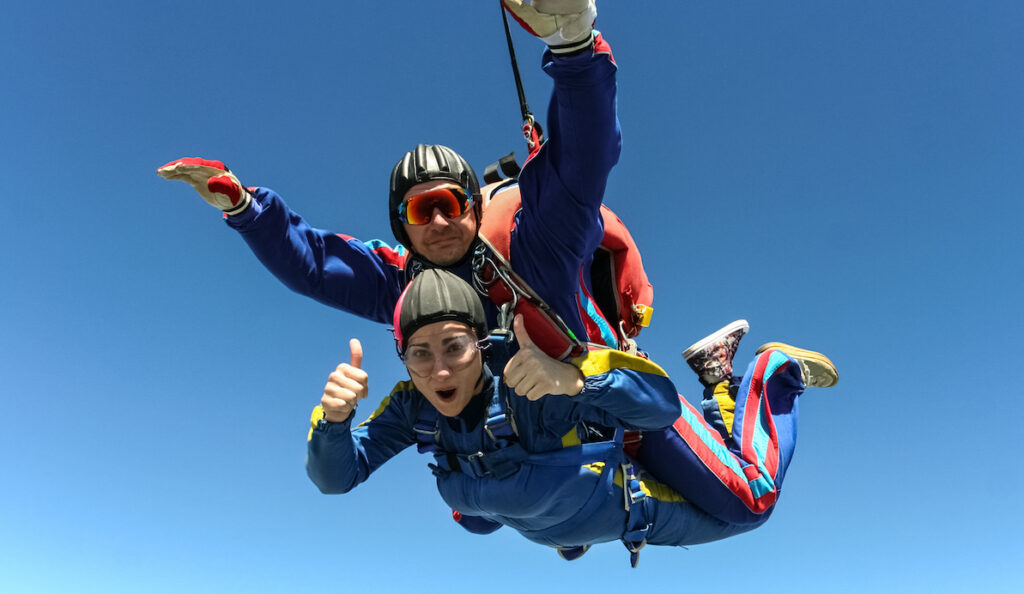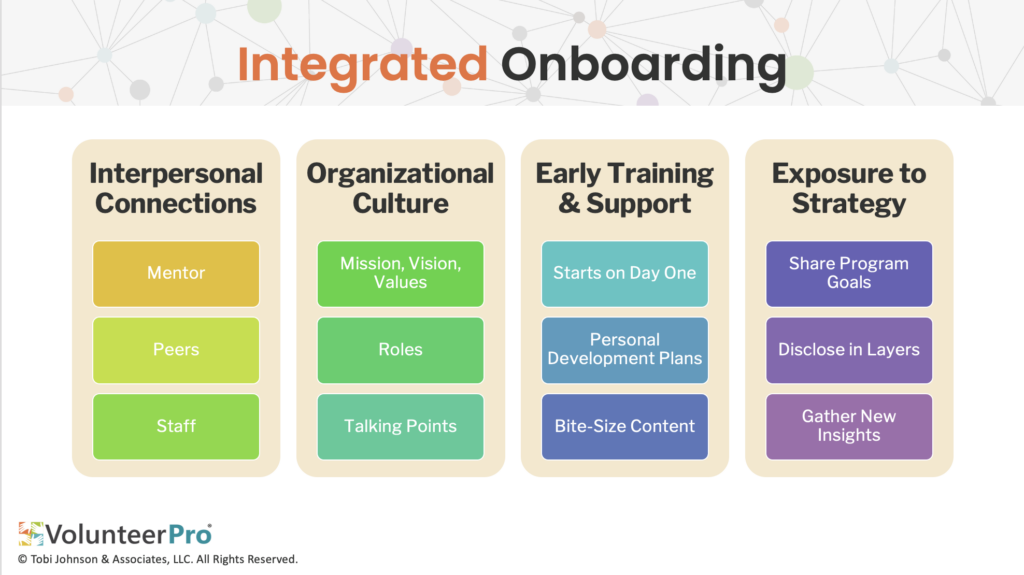How to Integrate Volunteer Onboarding for Better Engagement
Successful volunteer onboarding and deep volunteer engagement don’t happen by chance.
It takes a thoughtful, multi-layered strategy to convert joiners to stayers and to set the stage for future leadership.
We often think of onboarding as simply training volunteers on policies and procedures, then placing them, job done. But effective volunteer induction is more than that.
Even after they have been recruited, volunteers will continue to observe the organization and the people who work there (paid and volunteer alike).
Commitment is a process not a destination.
Even after volunteers join, they are still making a decision about whether or not they will stay.
They wonder — Does this organization match my values? Do I feel included? If this a well-run outfit? Can I make a real difference here? Is it worth my time?
The answers will influence how much they decide to invest and what they believe they can accomplish in partnership with you.
Want to know what your volunteers think? Ask them! Check out our Ultimate Guide to Writing Better Volunteer Surveys HERE >>
Volunteering is Like Skydiving
Think about it. Making a commitment to volunteer is a lot like jumping out of an airplane.
You may get on that airplane and take the ride up, but that doesn’t mean you’re going to jump. You’re not going to jump unless you get over your fears and you’re convinced it’s worth it.
What volunteers imagine their volunteer experience to be is not always what they find.
Because of this dissonance, during the onboarding process, newcomers negotiate a variety of conflicting emotions — surprise, fear, ambiguity, etc. — that result in changing perceptions and expectations.
They feel stress, too.
New volunteers must believe they have the capability to learn their new role and perform it to satisfaction.
They need to know they will be welcomed onto the team and supported accordingly. If they doubt their capacity, they may reduce their commitment or leave altogether.
So, a key goal of volunteer onboarding is to convince volunteers to take a leap of faith with us.
Wondering what you can do to improve the volunteer experience? Check out 4 Ways to Wow! New Volunteers with Superior Service HERE >>
Research has shown that there are four key dimensions of volunteer satisfaction:
- Group Integration – The relationships they form as a result of their volunteer work
- Participation Efficacy – His or her work makes a difference
- Organization Support – Adequate planning, training, & support for specific tasks
- Feelings of Empowerment – Freedom in deciding how to carry out assigned tasks
When you think about preparing for new volunteers, keep these in mind. Consider how your onboarding strategy can provide these and more.
Integrated onboarding takes these into account and then some.
4 Pillars of Integrated Volunteer Onboarding to Boost Engagement
Integrated onboarding includes a set of strategic processes designed to immerse the newcomer in the organization’s culture and vision, while socializing them to their new role and providing the tools and resources they need to understand the organization’s current trajectory and be successful.
There are many benefits of an integrated volunteer onboarding process, and there is a strong business case for developing or strengthening your volunteer onboarding process. It can help you …
- Reduce the replacement costs of volunteers
- Reduce the loss of customer service potential
- Accelerate the time to volunteer role competency
Below are four key pillars to keep in mind when developing an integrated volunteer onboarding strategy that goes beyond the traditional volunteer welcome.
Pillar #1: Interpersonal Connections
People commit to causes because they feel a connection to the people in them. Purposefully cultivating connections through mentoring, peer socializing, staff teambuilding, etc. can go a long way toward making newcomers feel welcome and quickly integrate them into the whole.
Pillar #2: Organizational Culture
New volunteers also need to be offered clues about “how we do things around here” in their induction process. This includes sharing clear information about how the organization’s mission, vision, and values play out in the real world, not just on a piece of paper.
It also helps for new volunteers to have a clear picture of team member roles throughout the organization and, of course, understand their scope of work and level of responsibility. Offering simple talking points volunteers can use to educate others about the organization’s work, also helps newcomers begin to contribute by raising community awareness from the get-go.
Pillar #3: Early Training Support
Although it may be weeks before the volunteer starts their first shift, their orientation should start on Day One, they day they are appointed or given a training date. Setting up ways to deliver bite-sized digital content is one way to start the acclimation process early.
Helping volunteers develop personal development plans for learning will help them better map their new context and take responsibility for learning goals.
Wonder if your current volunteer training is working? Check out our FREE Volunteer Skills & Training Feedback Form HERE >>
Pillar #4: Exposure to Strategy
Finally, transparently sharing agency and program-level aims and goals, disclosed in layers, so as not to overwhelm, can help volunteers align their goals with those of the organization and, at the same time, identify hidden skills and talents they might bring to the table.
This is also an excellent time to gather new insights around current strategies from volunteers with fresh eyes and perspectives.
These four domains are the essential ingredients of an integrated onboarding strategy that goes beyond simply recruiting and placing new volunteers.
Which can you put to use at your organization? Who will be responsible for implementation and management? What resources do you need to get started?
When implementing, consider how you can foster the following …
- Interpersonal Connections – How can you foster better relationships between new volunteers and peer mentors, other volunteers, and employees.
- Organizational Culture – How can you share the following in a creative an inspirational way?
- Your organization’s mission, vision, and values
- Roles of paid employees and volunteers
- Talking points about your organization and opportunities to support it
- Early Training Support – How can you share your organization’s culture (orientation), and the tasks volunteers will be responsible for (training) using these strategies – start on day one, develop volunteer personal development plans, designing bite-size content?
- Exposure to Strategy – How can you make new volunteers aware of your organizations strategic objectives early on without overwhelming them? How will you share program goals, share information in intervals instead of all at once, and gather insights form new volunteers about their experience so you can make smart improvements to your onboarding process.
Setting the stage for successful onboarding and deeper volunteer engagement doesn’t happen by chance. Take the time to design a process that works. this opportunity to connect and cultivate ongoing support for your cause.
FREE Tool: Map Your Volunteer Onboarding Journey
As leaders of volunteers, busy with the day-to-day details of our jobs, we sometimes lose sight of what our new volunteers might need. It helps to pause to consider their experience from their point of view.
A tremendous amount of time and energy goes into finding and selecting volunteer talent. Consider how a purposeful, integrated new volunteer induction process might ensure deeper commitment and foster future volunteer leaders.
Use our free Volunteer Experience Roadmap to map your new volunteer journey step-by-step and see how it can help propel your mission forward.
Through thoughtful journey mapping, you can …
- Enhance Value – What do volunteers need (or not need)?
- Streamline Recruitment and Onboarding – What’s the most efficient way to go about things?
- Deploy Team Members – What’s the best way to involve your team at each touch point?
- Achieve Outcomes – What tools, technology, and training does the team need?
Volunteer journey mapping also helps to decide which messaging and activities make sense at each step of the way.










[…] this trend, is to focus on improving each step of the volunteer’s journey through your onboarding process and by finding ways to improve the support you offer newcomers at each […]